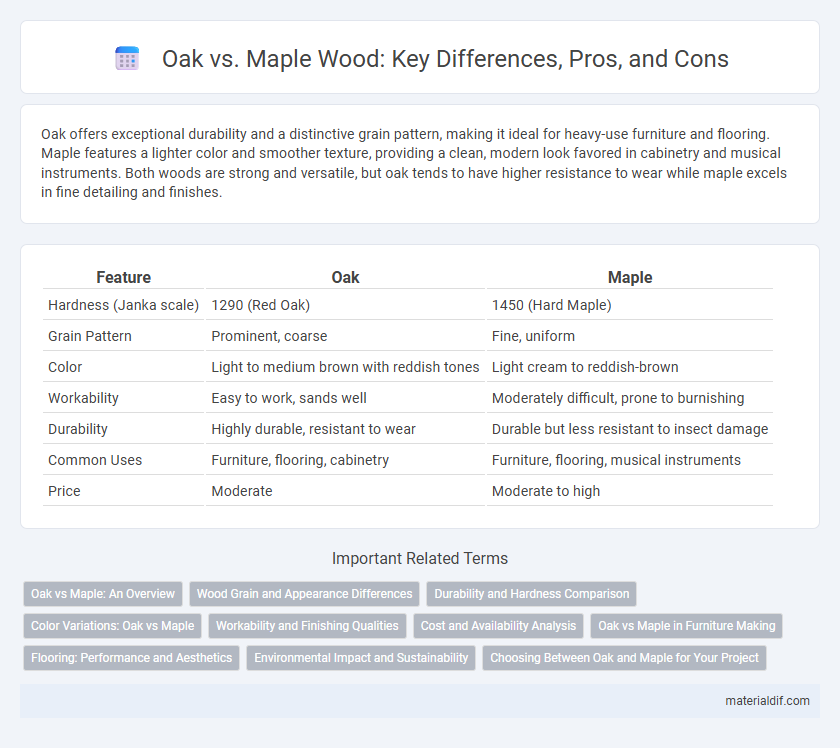Oak offers exceptional durability and a distinctive grain pattern, making it ideal for heavy-use furniture and flooring. Maple features a lighter color and smoother texture, providing a clean, modern look favored in cabinetry and musical instruments. Both woods are strong and versatile, but oak tends to have higher resistance to wear while maple excels in fine detailing and finishes.
Table of Comparison
| Feature | Oak | Maple |
|---|---|---|
| Hardness (Janka scale) | 1290 (Red Oak) | 1450 (Hard Maple) |
| Grain Pattern | Prominent, coarse | Fine, uniform |
| Color | Light to medium brown with reddish tones | Light cream to reddish-brown |
| Workability | Easy to work, sands well | Moderately difficult, prone to burnishing |
| Durability | Highly durable, resistant to wear | Durable but less resistant to insect damage |
| Common Uses | Furniture, flooring, cabinetry | Furniture, flooring, musical instruments |
| Price | Moderate | Moderate to high |
Oak vs Maple: An Overview
Oak and maple are two popular hardwoods valued for furniture and flooring due to their durability and distinct grain patterns. Oak features a prominent, open grain with a warm, reddish-brown tone, while maple exhibits a finer, more uniform grain and a lighter, creamy color. Oak tends to be harder and more resistant to wear, making it ideal for high-traffic areas, whereas maple's smooth finish suits detailed woodworking projects.
Wood Grain and Appearance Differences
Oak wood features a prominent, coarse grain with distinctive rays and flecks, creating a textured and rustic appearance ideal for traditional furniture and flooring. Maple wood exhibits a fine, consistent grain with a smooth surface and subtle pattern variations, often showing a curly or bird's eye figure, making it popular for modern, sleek designs. The color of oak ranges from light tan to medium brown with reddish hues, while maple tends to be lighter, displaying creamy white to light reddish-brown shades.
Durability and Hardness Comparison
Oak wood exhibits higher durability and hardness compared to maple, making it a preferred choice for heavy-use furniture and flooring. The Janka hardness rating for white oak reaches approximately 1,360 lbf, whereas sugar maple rates slightly lower at about 1,450 lbf, indicating comparable hardness but with oak offering superior resistance to decay. Oak's dense grain structure contributes to its enhanced toughness and longevity in high-traffic environments.
Color Variations: Oak vs Maple
Oak wood exhibits a rich spectrum of color variations, ranging from light golden brown to deep reddish hues, often with prominent grain patterns that enhance its warm and rustic appearance. Maple, in contrast, is typically lighter, showcasing creamy white to pale reddish tones with a smoother and more uniform grain, which lends itself well to contemporary and minimalist designs. These distinct color profiles influence their aesthetic applications, with oak favored for traditional, earthy interiors and maple preferred for bright, modern spaces.
Workability and Finishing Qualities
Oak offers exceptional workability due to its coarse grain and firmness, making it easy to shape and join, while Maple provides a smoother surface with a fine, uniform grain that enhances sanding and finishing. Oak's porous structure allows it to absorb stains evenly, giving rich color variations, whereas Maple's dense fibers can resist stains, often requiring pre-treatment for uniform finishing. Both woods respond well to various finishes, but Oak's openness makes it ideal for vibrant stains, and Maple excels in clear or light finishes highlighting its natural brightness.
Cost and Availability Analysis
Oak wood generally commands a higher price than maple due to its durability and popularity in high-end furniture, though maple often provides a more budget-friendly option for similar applications. Availability of oak varies regionally but is typically more abundant in North America and Europe, while maple is widespread in the northeastern United States and Canada, making both woods accessible but with differing market dynamics. Cost factors also depend on specific species, grading, and milling processes, influencing final pricing and availability in lumber yards and retail outlets.
Oak vs Maple in Furniture Making
Oak and maple are two of the most popular hardwoods used in furniture making due to their durability and aesthetic appeal. Oak is prized for its prominent grain patterns and robustness, making it ideal for heavy-use pieces like dining tables and cabinets, while maple offers a smoother, lighter finish that suits modern and minimalist designs. Both woods are resistant to wear, but oak typically provides greater strength and a more traditional look compared to the fine, uniform texture of maple.
Flooring: Performance and Aesthetics
Oak flooring offers superior durability and resistance to wear, making it ideal for high-traffic areas, while its prominent grain patterns create a warm, rustic aesthetic. Maple flooring, known for its hardness and smooth, fine grain, provides a sleek, modern look with excellent resilience against dents and scratches. Both woods excel in performance, but oak's rich texture contrasts with maple's uniform appearance, allowing for distinct design preferences in flooring projects.
Environmental Impact and Sustainability
Oak wood is known for its durability and slow growth, which means harvesting it can have a higher environmental impact due to the longer regeneration period compared to faster-growing maple. Maple grows relatively quickly and is often sourced from sustainably managed forests, making it a more eco-friendly choice with a smaller carbon footprint. Both woods can be sustainable options if harvested responsibly, but maple's faster growth rate typically offers better environmental benefits in terms of resource renewal and reduced deforestation pressure.
Choosing Between Oak and Maple for Your Project
Oak offers exceptional durability and a distinctive grain pattern, making it ideal for flooring and furniture that require strength and aesthetic appeal. Maple features a finer, more uniform texture and a lighter color, which enhances modern designs and allows for easy staining or painting. Selecting between oak and maple depends on your project's functional needs and desired visual style, with oak better suited for robustness and maple preferred for sleek, smooth finishes.
Oak vs Maple Infographic

 materialdif.com
materialdif.com